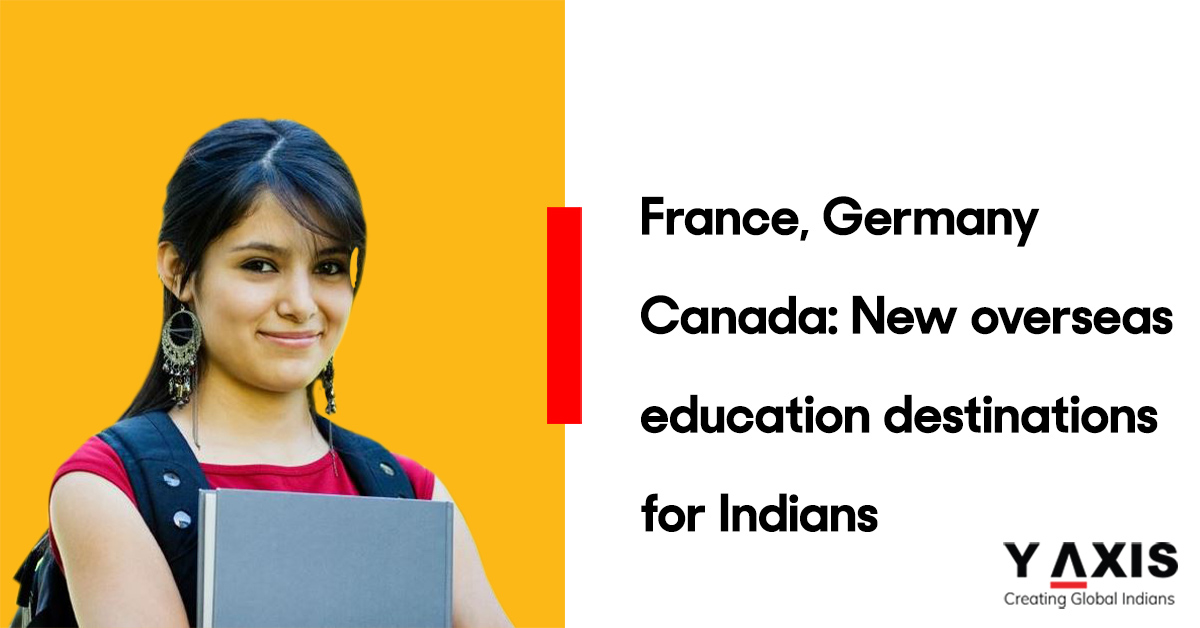Posted on May 03 2011
France, Germany & Canada: New overseas education destinations for Indians
By , Editor
Updated April 10 2023
Volumes of essays, English tests with formidable acronyms like TOEFL and IELTS and endless sessions with bank managers. It is a grind that swathes of students in India experience every summer to enter foreign educational institutes.
For years, the central characters of this plot have been universities in the US, the UK and Australia. Indian students who pack classrooms around the world - they are second only to the Chinese - did not dare look beyond these destinations for reasons as varied as job prospects to social recognition. Those days seem to be winding to an end.
Indian students are now turning their backs on the usual suspects for some of the very reasons they flocked to them earlier.
A raft of new destinations such as Continental Europe, Canada, Singapore, New Zealand and China are emerging as the new red-hot destinations. The map for overseas studies that was once concentrated on three regions finally resembles a spread.
Indeed, the fall in the number of students to the troika of the US, the UK and Australia has been too sharp to ignore. Nowhere else has the shift been more palpable than in Australia. The number of Indian students who chose the country dropped 77% in 2010 compared to the previous year.
In the UK, only 41,350 Indians went to study in 2010 against 57,000 in 2009. Even the US seems to be losing some of its sheen for Indian students as their numbers fell by 32% in 2009-2010 from a year ago. There are now more Chinese than Indian students in the US.
The biggest beneficiary of this shift has been Canada, where the number of Indian students rose 280% in 2010 compared to 2008. France is absorbing a steady increase of at least 20% Indian students a year. There were 15% more Indian students in Germany in 2009-10 from a year ago.
Though the Singapore government is yet to publish countrywise figures, education consultants say the number of Indian students picking that country has been rising nearly 20% a year since 2009.
"With Australia and the UK tightening visa rules and the slowdown hitting the job market in the US, Canada is emerging as a big overseas destination," says Dhiraj Mathur, executive director and leader, education, at PricewaterhouseCoopers India.
"Singapore, which provides good job opportunities after studies, too has seen an increase in the level of interest," he says.
Changing preferences
In Australia, the slump in the number of Indian students was fomented by the rash of racist attacks on Indians in 2009. That was followed by a clampdown by the government on dubious institutions, especially in vocational training, which was hugely popular with Indian students.
"Majority of students looking for a permanent resident status will be affected by the Australian government's attempt to delink education and migration through its new immigration laws," said Harmeet Pental of recruitment body IDP Education in an earlier interview.
A similar immigration story is playing out in the UK. Tighter rules—particularly the discontinuance of a two-year post-study leave to remain in the UK that non-EU students use for job hunting—is turning away Indian students. Foreign graduates will be allowed to remain in the UK only if they have skilled job offers under the UK Tier 2 work permit category.
"Restrictive visa and immigration policies in Australia and the UK make them less attractive," says Rahul Choudaha, director of development and innovation at World Education Services in New York.
Adds Ravi Lochan Singh, president of the Association of Australian Education Representatives in India: "The only bright spot is that Australia also offers an 18-month provision to work for experience post-education for two years. This will remain an alternative since the UK is clamping down on post-study work options from 2012."
The US has long remained popular in Indian campuses because of the optional practical training and curricular practical training programmes. These are avenues for international students to apply their classroom learning in the workplace.
The tough visa system in the US in the aftermath of the 9/11 attacks, however, has become a major deterrent for Indian students. Increasing cases of student visa frauds, the Tri-Valley University case still fresh in the minds of students, are likely to drive Indians to new destinations.
Continental shift
Drawing Indian students at the expense of the US and the UK are countries such as France and Germany. Education experts say this is more than an enrollment trend as these countries have made a calculated attempt to woo the Indian students, offering more courses in English.
A highly subsidised higher education system and world-class institutions are complementing the effort.
"German universities also offer a number of scholarships for students with excellent academic track records. About 15-20% of Indian students in Germany receive funding every year," says Apoorv Mahendru, head of operations of the education network South Asia German Academic Exchange Service.
Another magnet for Indian students is subsidised education in Germany. Most higher education institutions charge nil or little tuition fees. A student usually pays no more than e500 a semester. The total expenses, including housing, food and health insurance amount to around Rs 6 lakh a year.
In the US, fees for a graduation course alone are nearly Rs 11 lakh a year. The UK is more expensive, with fees at around Rs 20 lakh a year and another Rs 10 lakh in expenses.
Germany's efforts to woo foreign students are manifested in this data: up to 12% of its total students are foreign compared to 3% in the US, says a recent study by the British Council. Germany has trumped Australia, the UK and China as the country with the most number of foreign students, says the study that compares the overseas higher education systems in 12 countries on critical parameters.
Likewise, the French embassy in India along with CampusFrance has been looking to attract Indian students. More than 200 scholarships are handed out every year in India.
"Studying in France is not only about world-class institutions but also about understanding the European work ethos. Getting a student visa is not a problem and there are lots of scholarships available," says Ashish Kumar who holds a management degree from IESEG in Lille, France, and is now employed as a business development manager with a French company.
More scholarships, too, are in the works from French companies that are increasingly hiring Indians under the Quai d'Orsay Enterprises programme.
"The number of Indian students going to France doubled in the past five years to around 2,000 in 2010," says Philippe Cadene, attaché for scientific and university cooperation at the French embassy in India.
More hotspots
Canada is another destination that is fast emerging as a hotspot of Indian students. The country issued 12,000 study permits in India in 2010 against 3,152 in 2008.
"We see applicants in a wide variety of programmes from PhDs to community colleges and from engineering to hospitality. Business and commerce programmes remain particularly popular," says David Manicom, minister (immigration), High Commission of Canada, New Delhi.
The Canadian Experience Class visa programme and post-study work permits offer flexibility to foreign students. Chances of a canadian permanent resident status are high thanks to two-year programmes at publicly funded colleges.
Canada also introduced a student partners programme last year, which has opened admissions in private colleges for Indian students.
Students also factor costs. Amit Arora, who is to join an MBA course at the Sauder School of Business
at the University of British Columbia in Vancouver in August 2011, preferred Canada to the US. "While a top business school in Canada costs around Rs 22 lakh, fees work out to almost Rs 40 lakh in the US.
Besides, living expenses are higher in the US," he says. Arora also chose Canada for its 'fast-track' MBA course of 16 months and easier student visa norms.
Nearer home, Singapore is turning out to be another choice destination. Nanyang Technological University and National University are popular among Indians. Singapore is also known for world-class institutions and a cosmopolitan lifestyle.
Experts say students target quality education, but they will never ignore costs. Therefore, new countries will emerge as education destinations. In recent years, China New Zealand and Russia too have begun attracting Indian students.
"The continued interest of Indians to study abroad is a complex interplay of variables, including job prospects, cost of education, availability of quality local programmes, social recognition and opportunities of immigration," says Choudaha. "Depending on students' socio-economic background one variable may be more important than others."
01 May 2011
Ishani Duttagupta and Binoy Prabhakar
For more news and updates, assistance with your visa needs or for a Free Assessment of your profile for Immigration or Work Visa’s just visit www.y-axis.com
Tags:
Indian Students Abroad
Study Overseas
Y-Axis.com
Share
Options for you by Y-Axis
Get it on your mobile
Get News alerts
Contact Y-Axis

